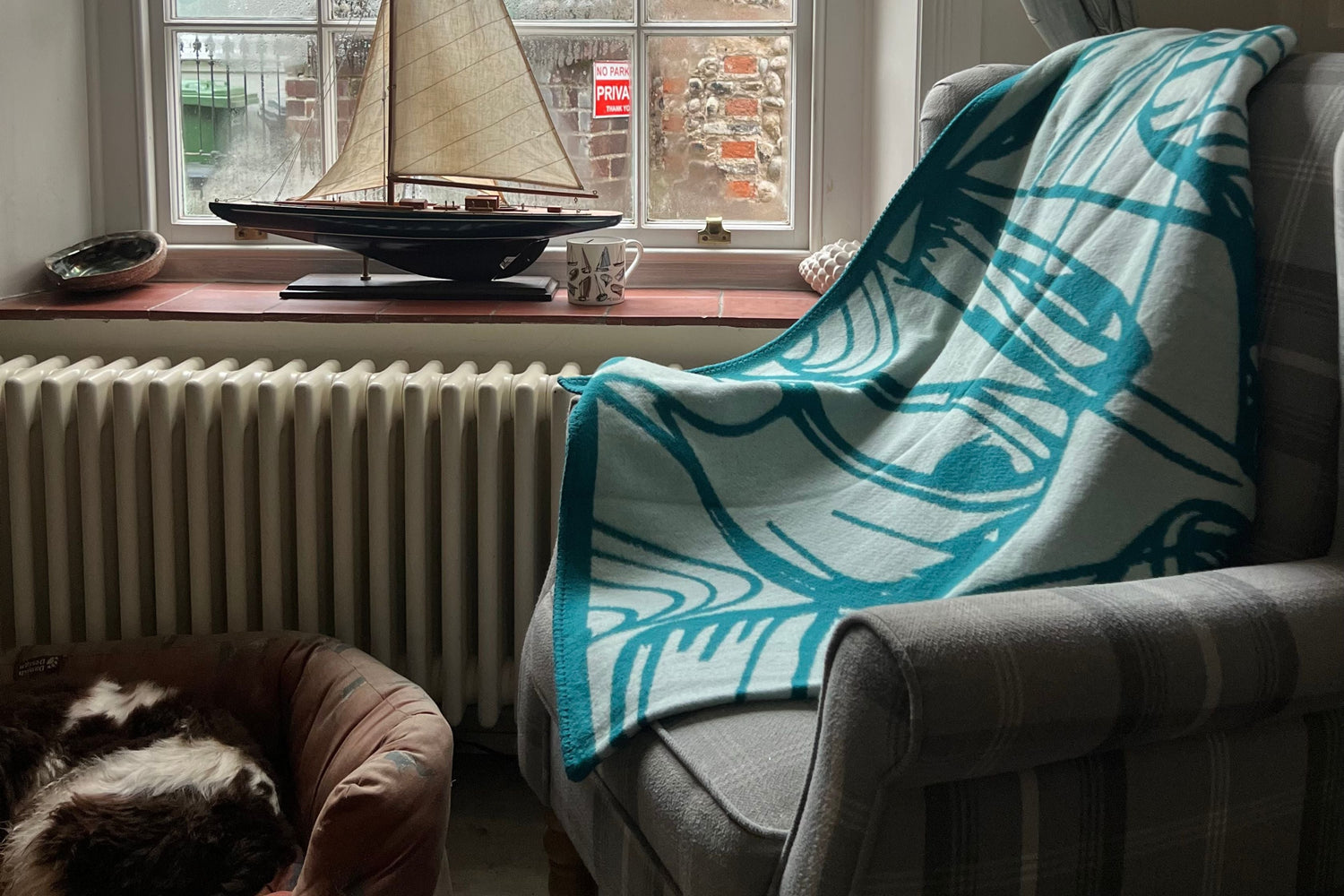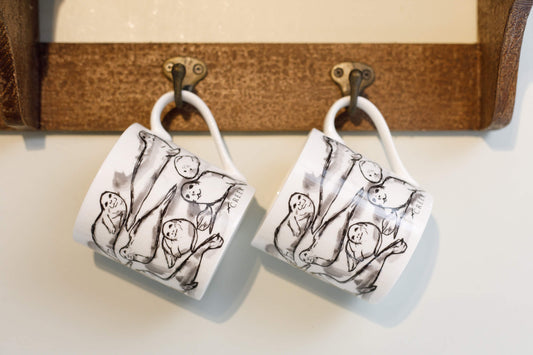Bone China vs Porcelain: What's the Difference?
Ever found yourself confused by elegant tableware, wondering what makes each piece unique? When picking out dishes for a dinner party or everyday use, bone china and porcelain often spark a delightful debate.
These two remarkable ceramics have their own special traits and histories. Bone china first appeared in Stoke-on-Trent over 220 years ago. Porcelain, on the other hand, has been a part of Western culture for centuries, with roots in China's Tang dynasty.
Both materials create beautiful dinnerware that can make any meal special. Bone china is known for its clear look and strength. Porcelain, with its durability and versatility, is perfect for your table settings.
Introduce British craftsmanship to your home with our Inky Seals Mug, made from fine bone china in the UK. This guide will help you understand these materials better. It will assist in choosing the right tableware that matches your style and needs.
Key Takeaways
- Bone china originated in Stoke-on-Trent over 220 years ago, while porcelain dates back to China's Tang dynasty
- Despite similar appearances, these materials have distinct compositions and characteristics
- Bone china typically contains actual bone ash, giving it unique translucency and strength
- Both materials make excellent choices for special occasion and everyday tableware
- Quality bone china and porcelain pieces can become cherished heirlooms passed through generations
- The UK has a rich heritage in producing world-renowned bone china
Understanding Bone China and Porcelain
Bone china and porcelain are top-notch ceramics, each with special qualities. They have been loved for centuries. Though they look alike, they are made differently and have unique features.
These materials have a long history. They've been on royal tables and in homes for special events. Their beauty and use make them popular.
What is Bone China?
Bone china is a fancy type of porcelain. It includes bone ash in its making. It was first made in England in the 1700s by Thomas Frye.
It's made from 25% kaolin, 25% Cornish stone, and 50% bone ash. This mix makes it both delicate and strong. High-quality bone china has at least 30% bone ash.
The bone ash makes it look creamy white and clear. When fired at 1200°C, it becomes light but strong. This makes it perfect for fancy dishes.
What is Porcelain?
Porcelain comes from ancient China. It was first made during the Tang dynasty. Europeans couldn't make it until the late 1500s.
It's made from kaolin, feldspar, and quartz. Fired at 1400°C, it turns into a hard, white, and non-porous material. It sounds different when tapped.
There are two types: hard-paste and soft-paste. Hard-paste follows the Chinese formula. Soft-paste was made by Europeans trying to copy Chinese methods. Learn more about porcelain's world history and its impact on ceramics.
|
Characteristic |
Bone China |
Porcelain |
|
Primary Components |
Kaolin, feldspar, bone ash |
Kaolin, feldspar, quartz |
|
Firing Temperature |
~1200°C |
~1400°C |
|
Appearance |
Creamy white, highly translucent |
Bright white, slightly blue-grey undertone |
|
Origin |
England, 18th century |
China, Tang dynasty |
|
Distinctive Feature |
Contains animal bone ash |
Completely mineral-based |
What is Better: Bone China or Porcelain?
Bone china and porcelain are both top-notch for your tableware. They differ in what they're made of, how long they last, how they look, and how they feel. Which one is better depends on what you need and like. Let's look at the main differences to help you choose the best for your home.
Composition and Manufacturing
Porcelain is made from kaolin, feldspar, and quartz. It's fired at very high temperatures, making it non-porous and glass-like.
Bone china, on the other hand, has bone ash (30-50%) and similar minerals to porcelain. It's fired at slightly lower temperatures. This makes bone china thinner and more delicate.
Because of the bone ash, making bone china is more complex. But many think it's worth the extra effort for its unique qualities.
Durability and Strength
Bone china looks delicate but is actually very durable. The bone ash makes it less likely to chip. This makes it great for daily use.
Knocking a bone china plate against another is less likely to cause chips. This makes it perfect for busy homes.
Porcelain is strong but can be more brittle. Its thickness can help it withstand falls better.
Appearance and Translucency
Bone china has a warm, creamy white colour with ivory undertones. Porcelain is cooler and whiter, with a slight blue-grey cast.
Bone china is translucent, showing shadows through thin pieces. This gives it a refined, elegant look.
Porcelain can also be translucent but looks more opaque. It reflects light differently, showing a subtle but noticeable difference.
Weight and Feel
Bone china feels light and elegant. It's surprising when you first hold it.
Its lightness and thinness make it feel luxurious. It's perfect for any meal, from special occasions to everyday breakfast. Despite being light, it doesn't feel fragile.
Porcelain, on the other hand, feels heavier and more solid. It's great for everyday use because of its robust feel. The weight difference is clear when comparing similar pieces.
|
Feature |
Bone China |
Porcelain |
Best For |
|
Composition |
Kaolin, bone ash (30-50%) |
Kaolin, feldspar, quartz |
Bone china for luxury feel |
|
Durability |
More chip-resistant |
More brittle at edges |
Bone china for everyday use |
|
Appearance |
Warm ivory tone, translucent |
Cooler white, less translucent |
Bone china for elegant settings |
|
Weight |
Lightweight, delicate feel |
Heavier, substantial feel |
Porcelain for sturdy feel |
|
Price |
Typically higher |
Generally more affordable |
Porcelain for budget-conscious |
Practical Considerations for Your Home
Your lifestyle and household habits are key in choosing between bone china and porcelain. Bone china is durable for everyday use, despite looking delicate. Porcelain is sturdy, perfect for homes with kids.
Both are great for modern kitchens. Most are dishwasher-safe, but hand wash those with gold or silver trim. Clean with mild detergent and soft cloths to avoid damage.
Temperature matters for both. Modern pieces might be microwave-safe, but extreme changes can harm them. Avoid sudden temperature shifts to prevent damage.
When storing, use padding to prevent scratches. Metal utensils and hard items can damage your fine china or porcelain.
At Creek, we draw inspiration from nature. We design sustainable, timeless pieces that reflect coastal beauty. Removing dried food or stains needs patience. Never use knives, forks, or nails to remove stains.
Choosing between bone china and porcelain depends on your needs and taste. Both can last for generations with the right care.
Shop Bone China and More
Explore our bone china mugs, elegant, UK-made, and inspired by the calm of the coast. Pair them with our coastal kitchenware for a beautifully curated kitchen and dining space.
Want to see the collection in person?
Visit our flagship store in Wells-next-the-Sea:
Creek Lifestyle
14 High Street, Wells-next-the-Sea, Norfolk, NR23 1EP
📍 Find Us Here
FAQ
What is the main difference between bone china and porcelain?
Bone china has bone ash (30-50%) mixed with other minerals. This gives it a warm look and surprising strength. Porcelain, made from minerals only, has a stark white colour with a slight blue-grey undertone.
Which is more durable - bone china or porcelain?
Bone china is surprisingly more durable than it looks. The bone ash makes it less brittle and more resistant to chipping. Porcelain is strong but can chip more easily, though its thickness helps it withstand falls better.
Is bone china or porcelain better for everyday use?
Bone china is great for daily use because it's durable yet elegant. Its chip-resistance makes it practical. Porcelain is also good for everyday use, if you like a heavier feel.
How can I tell if I have bone china or porcelain?
Check the light through it - bone china is translucent. It has a warmer white than porcelain. Bone china is lighter and thinner but feels strong. Tapping it gently will show a different ring than porcelain.




